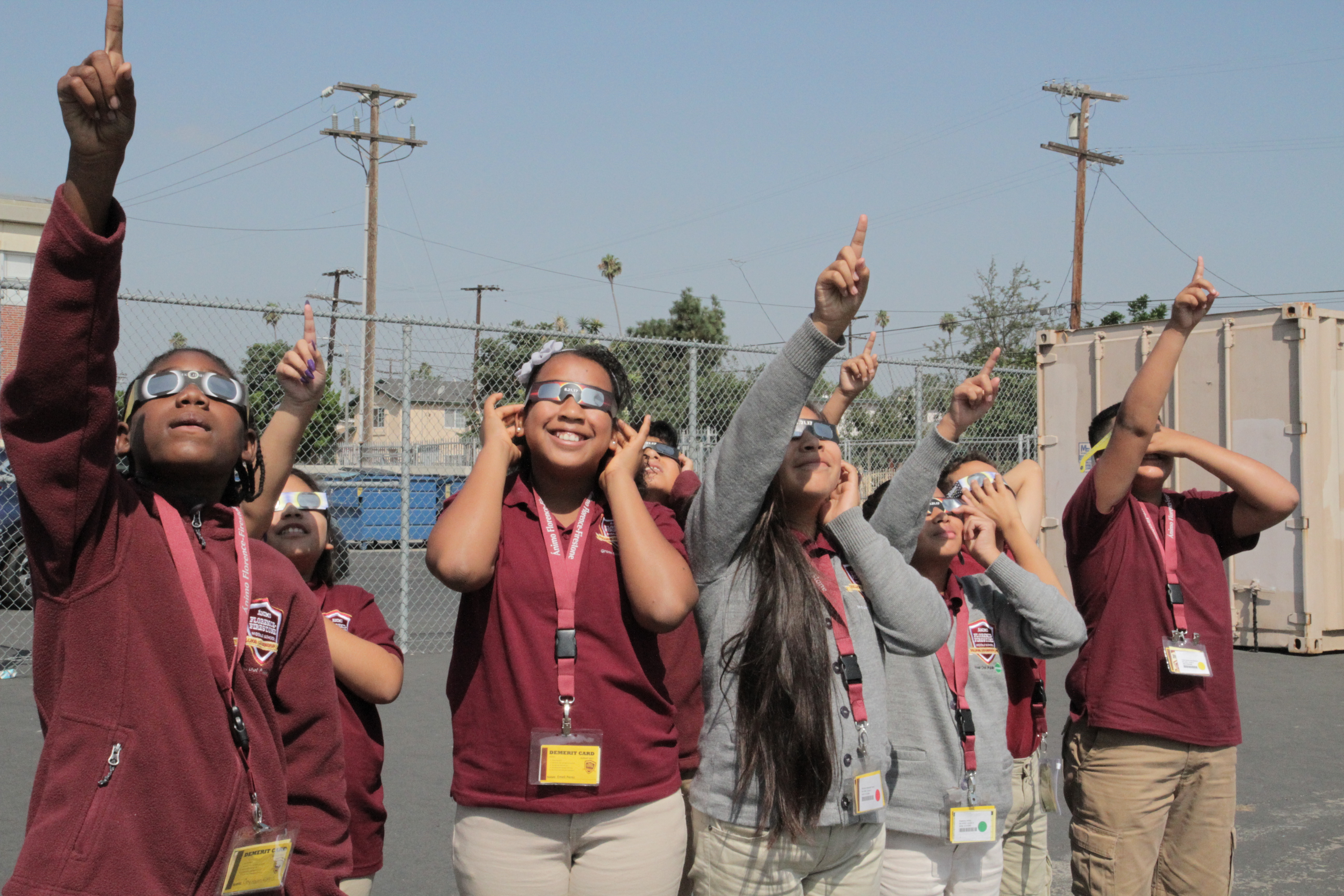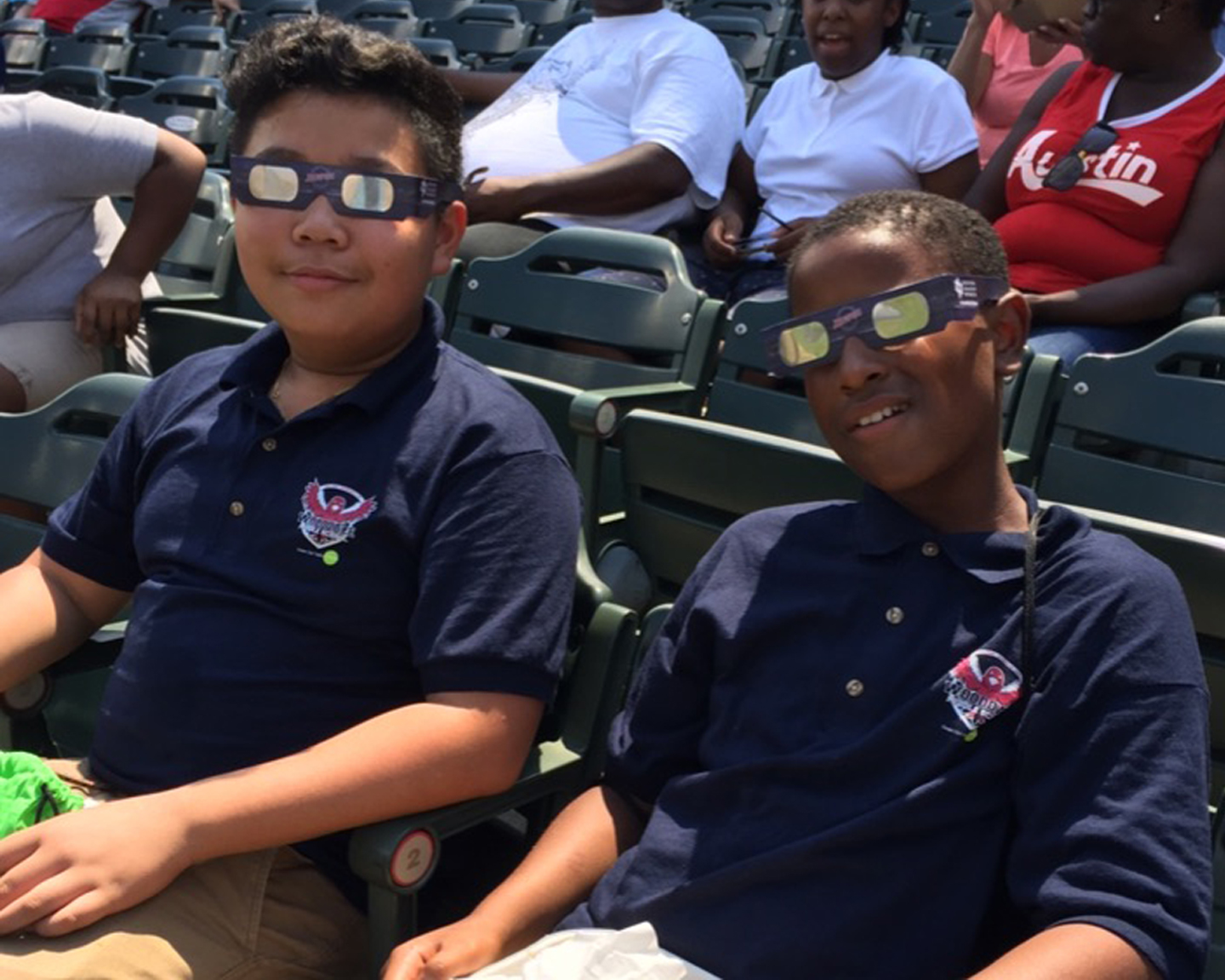Solar Eclipse Sparks Curiosity of Green Dot’s Young Scientists Across the Nation

This summer, Green Dot students witnessed the first total solar eclipse in the United States since 1979. Green Dot educators saw this as a great opportunity to continue linking current events and natural phenomena to the classroom, encouraging students to tap into their innate curiosity.
Exploring Natural Wonders

For many Green Dot schools, this celestial event laid the groundwork for students’ science experience in the new school year. Schools across the Green Dot network found different ways to incorporate the eclipse into their curriculum. Staff at Ánimo Florence-Firestone organized a school-wide viewing so that every student could experience the phenomenon and apply the scientific method. That morning before the viewing, classrooms on campus buzzed with excitement. Students were asked to review resources from their teachers that helped them describe and discuss what they believe an eclipse to be, forming a hypotheses of their own.
While students in California saw 62% of the sun blocked out, Green Dot students in Tennessee witnessed a near totality, with 92% of the sun blocked out because of their proximity to the moon’s path. Students at Wooddale Middle School visited Autozone Park in Memphis to view the eclipse. They joined thousands of people, to experience what many consider a once-in-a-lifetime opportunity.
Green Dot students in Washington State were also able to see a 92% eclipse, viewing it together during the first few hours of their first day of school. “I hope students take away a burning desire to ask and answer questions about the things occurring around them,” said Alexis Hauber, Destiny Middle School physical science teacher.

In mere hours, students would witness their first solar eclipse and have the opportunity to test their hypotheses. “I think the moon moves around, and its shadow hits earth, and whatever spot it lands on creates a solar eclipse,” shared Diego Rincon, sixth grader at Ánimo Florence-Firestone.
At 10:15 a.m., students eagerly shuffled towards the quad, science journals and eclipse shades in hand. “What do you think it’s going to look like?” and “How dark is it going to get?” were just some of the questions that could be heard as students anxiously awaited the eclipse. “It looks like the moon is slowly covering the sun, just like I thought it would,” rejoiced Jocelyn Delgadillo, sixth grader at Ánimo Florence-Firestone.
“As educators, we hope students gain an increased ability to synthesize pieces of evidence into a cohesive explanation of an occurrence, and a greater appreciation, if not love for science!”
No matter where they were, viewing the eclipse further fueled students’ curiosity. “I thought the moon was going to fully cover the sun, but it looked like a little banana,” chuckled Rosa Perez, sixth grader at Ánimo Florence-Firestone. “I’m excited to discover why we saw a partial eclipse, while people in other places saw a total eclipse.”
Empowering Young Scientists

Over the past several years, science education has shifted from teaching mere facts to producing inquiry based learning environments, where educators are posing problems, questions, and scenarios, rather than presenting established facts.
When students encounter these problems and scenarios, it allows them to take ownership of their learning experience, as it is now driven by their own curiosity. “At Green Dot, we are really building within our students the belief that they have the ability to seek out, solve, and answer their own questions,” said Green Dot Curriculum Specialist, Brittney Rupert.
No longer is the role of a science teacher to be just a bank of knowledge, but rather a model of how scientists think–scientists question how something works or why it occurs, create experiments, collect evidence, refine their explanations, and repeat the process.
There is no one scientist who holds all the answers. Educators at Green Dot are working to empower students to become young scientists.
“When you look at kindergarten classes, you often see hands going up left and right, but as you go through the grade levels you slowly start to see hands go down,” said Rupert.
“Often times students’ curiosity and questions are kind of shut down because it’s not on the agenda for today.”
“When you look at kindergarten classes, you often see hands going up left and right, but as you go through the grade levels you slowly start to see hands go down.” – Brittney Rupert
That’s why Green Dot science classrooms are focusing on revealing science in the world around us, regularly exposing students to natural phenomena via videos, experiments, and current events. This can be events as large as a solar eclipse, or small as figuring out how the enzymes in laundry detergent pods work. “Doing science in the “real world” involves creating explanations of and/or solutions for these occurrences,” said Hauber.
“Unfortunately, many phenomena we share are not directly observable by students – they must watch videos and read articles to generate observations. The eclipse provided a real-life, in-your-face example of these natural events, and I am so stoked our students got to experience it.”
Science as a Means to Level the Playing Field
Creating equity of opportunity is core to Green Dot’s identity and our work as a social justice organization. For far too long, schools have left a large number of students from underserved communities without the advanced skills and knowledge necessary for college and careers in the 21st Century workplace.
The availability and supply of STEM employees remains a concern for many U.S. companies due to the exponential growth of STEM jobs. According to the U.S. Department of Commerce, over the past 10 years, growth in STEM jobs was three times as fast as growth in non-STEM jobs.
“At Green Dot, we are providing students with exposure and access to those fields by building and developing the skills that they’ll need to eventually get to those areas if they wish,” said Rupert. Too often a student’s zipcode or socioeconomic status limits their access to a high quality education, including exposure to advanced STEM skills and careers. That’s why, at Green Dot, our educators are working to ensure all students have access to a personalized, rigorous education that exposes them to stimulating experiences, and helps them build skills we know are vital to their success in both STEM and non-STEM fields.
